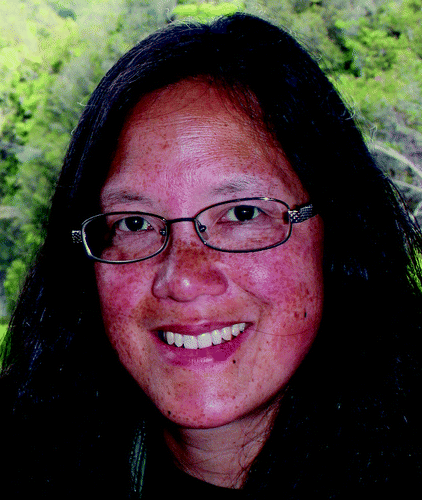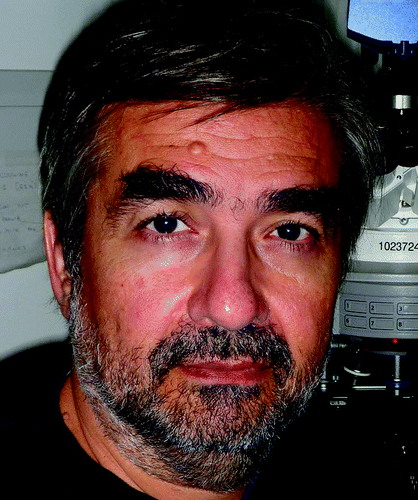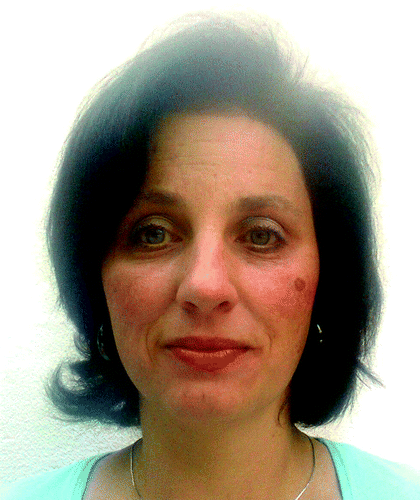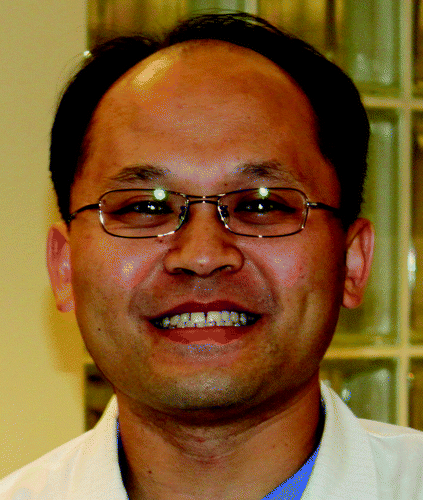Email: [email protected]
Research focus
Mitochondrial homeostasis and cell signaling in neurodegeneration
Model system
Cortical and midbrain neurons, SH-SY5Y cells, mutant mice
Education and career
1993, Ph.D. in pathology-biochemistry, Duke University School of Medicine; advisor: Salvatore V. Pizzo. 1994, M.D., Duke University School of Medicine. 1994–1998, anatomic pathology and neuropathology residency with postdoctoral fellowship in neuro-oncology, Duke University; research advisor: Darell D. Bigner. 1998–present professor, assistant professor, associate and currently professor of pathology, University of Pittsburgh School of Medicine.
Why do you study autophagy?
One of the joys of science is that you never know exactly where the data will lead you. My journey into the world of autophagy began with a $5 bet and the discovery that instead of trafficking to the nucleus, the kinase we were studying decorated mitochondria undergoing autophagy in degenerating Parkinson disease neurons. At that time, the Atg8/LC3 conjugation system had been discovered, and the potential research implications resonated with both the biochemist and the morphologist in me (derived from my Ph.D. in covalent protein modifications and my training as a diagnostic pathologist, respectively). I predicted that autophagy was going to comprise the next big wave for human disease research, and signed up for the first Gordon Research Conference in 2003 to learn more about its basic regulation. The people in the field have turned out to be generous and fantastic colleagues, and it has been highly rewarding to be part of this growing community.
What do you think is a key question(s) in the autophagy field? Or, where do you think the field is heading?
Key questions include mechanisms underlying cell type-, stimulus- or cargo-specific responses and how these interact with or modulate the classical autophagy pathways. It is likely that the regulation of autophagy is not a linear process, but rather involves integration of a network of signaling inputs. My first exposure to autophagy was during my clinical training, years before I rediscovered it as a researcher. I was taught that despite its striking ultrastructure, it was not diagnostically useful as it represented a “nonspecific cellular response to many kinds of stress.” Of course, the concept of selective autophagy has now moved to the forefront in fields such as Parkinson disease, given growing molecular evidence that cargo sequestration may play a pivotal role in familial neurodegenerative diseases.
A second emerging theme reflects mechanisms that balance and cross-regulate autophagic degradation and biosynthetic/regenerative responses to cellular injury. For example, our recent study in chronic MPP+ toxicity suggests that the capacity for aging or diseased neurons to upregulate mitochondrial biogenesis may determine the overall outcome of mitophagy-inducing injuries. As a cellular recycling response, impairment at any step of the process—autophagy induction, cargo targeting, maturation/degradation or reutilization of liberated molecules—may represent a potential future target for disease-modulating therapies.
If you could start over and choose a different career, what would it be?
If I were brave enough to jump off the well-lit path up the medical ivory tower, I would be a food anthropologist or photojournalist, traveling the world to study the interplay of culture and cuisine, or poking around in the secret lives of obscure animals and plants.
What one scientific discovery do you wish you had made?
The discovery of adapter proteins such as SQSTM1/p62 that target ubiquitinated cargo for autophagy. This work has really opened up the field for envisioning mechanisms of selective autophagy in mammals. We have been working on and off on another hypothesis concerning cargo recognition since 2004, following the report of the LC3 crystal structure and a chance meeting with a previously unknown Pittsburgh colleague in St. Thomas. So there really is a good reason to attend smaller scientific conferences in beautiful locations.
Personal comments
I enjoy hiking, eating (and thinking about food), vacation travels with my husband and children, reading (mostly science fiction/fantasy), snorkeling, and chow chows (a furry dog breed that, according to legend, was allowed to lick up pieces of the sky that fell during creation). One of my favorite places is a tiny projection of land near Monterey, CA, the Point Lobos State Natural Reserve. This is where I discovered hiking on a family trip away from the concrete world of Los Angeles, gaining an appreciation for trees as well as tide pools, and decades later heard, then saw, a sea otter eating in the wild.
Email: [email protected]
Research focus
Cell traffic and lipid signals; early autophagy events
Model system
Mammalian cells in culture
Education and career
1983, B.A., Bard College, New York, NY USA. 1987, PhD, University of Texas at Dallas, USA; advisor: Dr. Dimitrij Lang; I worked on the structure and assembly of bacteriophage ϕ6. 1988–1991, 1992–1993, postdoc; advisor: Dr. Michael Roth; I worked on endocytosis and other trafficking pathways. 1993–1996, instructor, University of Texas Southwestern Medical Center, Dallas, TX USA; I worked on lipid signals and trafficking. 1996–present, Group Leader, Babraham Institute, Cambridge, United Kingdom.
How did you get into the autophagy field?
I started working on autophagy in 2005, only because some dots we were trying to characterize in cells did not colocalize with any known organelle markers. The work took us towards trying to identify the origin of the autophagosomal membrane, and we still spend quite some time on this question. We identified a membrane structure which we termed omegasome that forms early during autophagy induction, in close connection to the endoplasmic reticulum and is enriched in phosphatidylinositol 3-phosphate, within which some autophagosomes form. Our current work aims to understand the requirements for omegasome formation and the relationship of these membranes with upstream and downstream components.
What do you see as some of the key questions in the field?
What I find most fascinating about the autophagic pathway is that it quietly works behind the scenes in all sorts of settings, and its effects show up only when it is inhibited. The phenotypes of knockout animals, especially when autophagy is eliminated in distinct tissues, are a constant source of surprise and wonder. We are currently thinking a lot about basal autophagy, and why it seems to be so variable between cell types. The current idea, that it serves some type of general quality control function, may turn out to be only partially true. It wouldn’t surprise me if the basal pathway turned out to be a bona fide trafficking route as well, that continuously delivers stuff to the lysosomes or elsewhere. Another intriguing aspect of autophagy is the way that it is wired into the rest of the signaling networks. On the face of it, autophagy seems to connect somewhat selectively to growth factor signaling, and it doesn’t respond dynamically to many stimuli. At the same time, and given that the autophagic response is such a commitment step, it is perhaps not surprising that it probably kicks in only when some important thresholds are reached. It will be really exciting to understand this aspect of autophagy in the future.
Do you have any other thoughts about the autophagy field in general?
Apart from the fascinating set of questions, it is lucky that autophagy is led by very decent scientists who are helpful to younger or more junior colleagues. This is not true in a lot of other fields, and I hope it continues as the field expands. The historical vignettes that are provided once in a while in Autophagy by Dan Klionsky talking to the elders are really invaluable for anybody wishing to understand the origin and big questions of autophagy. This sort of narrative provides coherence to the field. Regrettably since I came late into autophagy, I missed some of these scientists when they were in full swing.
Are you involved in teaching?
Our institute only accepts Ph.D. students, so we are dealing with people who have already gone through a lot of training and most of their theoretical education has been set. Nevertheless, it is very interesting to be part of the maturation of somebody from “promising and good student” to “emerging young scientist,” and to look at the different ways that this transition can happen. I have ambivalent feelings about those students who decide on alternative careers before they had a chance to measure themselves as scientists, and I am not sure that providing them with too many options at the beginning of their Ph.D. is the right thing to do.
Personal comments
In the immortal words of American singer and songwriter Willie Nelson, It’s Been Rough and Rocky Travelin. Working on this project has been full of adventures, two of which illustrate the point. The first thing we decided to do when we started studying ZFYVE1/DFCP1 (the protein that led us to autophagy) was to make an antibody against it. After working for several days to make some baculovirus-expressed protein, we shipped the valuable tube by courier to the company making the antibody. Next day we were informed that the truck carrying our protein had been hijacked (the first such incident ever), and everything inside was stolen! Back to the insect cells to make some more. Fast-forward a few years and now working full time on ZFYVE1. As our first manuscript was submitted to its original journal (far removed from its final resting place…) the server containing all our movies crashed, and everything was lost. Fortunately I had kept local copies, but only because I was working on them from home during the Christmas break.
Email: [email protected]
Research focus
Understanding signaling networks of tumor suppressor and metastasis inhibitor genes; uncovering molecular mechanisms by which apoptosis and autophagy are interconnected; exploring developmental functions of autophagy
Model system
The nematode Caenorhabditis elegans
Education and career
1995, biologist, Eötvös Loránd University (ELTE), Budapest, Hungary. 1999 advisor: Prof. Fritz Müller. 2004–2007, research fellow at the ELTE University, Budapest. 2007–present, assistant professor, ELTE. 2012, habilitation.
Why do you study autophagy?
In 2002, I was interested in the developmental function of bec-1, which is the worm ortholog of the human tumor suppressor gene BECN1. At that time, there was no literature record on genetic analysis of any metazoan autophagy gene. We found that BEC-1 forms two different complexes in the nematode. First, BEC-1 physically interacts with LET-512/PIK3C3, the class III PtdIns 3-kinase. Second, it is also able to form a separate complex with the anti-apoptotic factor CED-9/BCL2. Furthermore, we found that inactivation of bec-1 triggers apoptotic cell death in the nematode. In some bec-1(-) mutant embryos, most of the cells undergo apoptosis. Thus, we showed that bec-1/BECN1 represents a link between autophagy and apoptosis. Autophagy is known as an alternative form (type II) of cell death. How the regulation of autophagy is linked to that of apoptosis, and how the two cell death processes are interconnected, remain fundamental questions in biology.
To further assess the relationship of the two processes, we generated double-mutant worms deficient in both apoptosis and autophagy. Interestingly the double knockouts arrested development during embryogenesis, while single mutant nematodes defective for either apoptosis or autophagy are viable and fertile. These data suggest that the two processes are redundantly required for normal development and viability in this organism. In addition, we identified a basic region leucine-zipper (bZip) transcription factor (ATF2) that might coregulate the autophagic and apoptotic processes under stressful conditions and/or during development. Because both processes are evolutionarily conserved across divergent animal phyla, similar developmental roles and shared regulatory mechanisms might also operate in higher organisms.
We are currently assessing specific developmental roles of autophagy in C. elegans and in the fruit fly Drosophila melanogaster. We also intend to uncover regulatory proteins that developmentally control autophagic degradation.
Why is the field of autophagy important to you?
Autophagy, as a cellular “self-eating” mechanism, primarily promotes cell survival; the end products of autophagic degradation can be used to supply the cells with energy and also provide building blocks for macromolecule synthesis. Indeed, accumulating evidence suggests that autophagy acts as a largely cytoprotective mechanism in physiologically relevant conditions. In these circumstances autophagy negatively influences apoptosis, and apoptotic signaling, in turn, seems to inhibit autophagy.
One of my major goals is to understand the dual role of autophagy in cell survival and death: what are the conditions when autophagy contributes to, or mediates cell death, and, on the contrary, in which cellular context does autophagy enable cells to escape from undergoing death? Deciphering regulatory circuits of the autophagic machinery and their potential overlap with that of apoptosis might answer these questions. Although many signal transduction pathways were identified that regulate autophagy at the translational level, transcriptional control of autophagy genes remains largely elusive.
Recently, another topic I became interested in is the characterization of several metastasis inhibitor orthologs in C. elegans. The aim of this work is to investigate the relation of metastasis inhibitors to different cell death mechanisms.
What do you think is a key question in the autophagy field?
Finding the tools by which one can measure autophagic activity in human individuals. It is also important to know those regulatory proteins that control autophagic activity during development.
Personal comments
I am married to another autophagy researcher, Tibor Vellai and we have two children. Although I drive an independent research group with separate topics, we share some autophagy-related projects. I try to keep family life and research in balance, which is often not an easy task. I like reading, going to the theater and traveling: these activities help me to relax and reinvigorate my mind.
Email: [email protected]
Research focus
The role of damage-associated molecular pattern molecules (DAMPs) and their receptors (DAMP-R) in inflammation, immunity and cancer
Model system
Human cancer and normal cell lines; xenograft and transgenic mouse models of pancreatic cancer
Education and career
2000, M.D., Norman Bethune College of Medicine, Jilin University, Changchun, China. 2000–2002, teaching assistant, Department of Pathophysiology, Xiangya School of Medicine, Central South University, Changsha, China. 2007, Ph.D. in pathophysiology, Xiangya School of Medicine; advisor: Xianzhong Xiao. 2007–2009, postdoctoral scholar, Department of Surgery, University of Pittsburgh Cancer Institute, University of Pittsburgh, Pittsburgh, USA; advisor: Michael T. Lotze. 2010–2011, research assistant professor in the Department of Surgery, University of Pittsburgh. 2011–present, assistant professor in the Department of Surgery, University of Pittsburgh.
Why do you study autophagy?
Cell death and injury often lead to release or exposure of intracellular molecules called DAMPs. These molecules are recognized by pattern recognition receptors (e.g., RAGE and TLRs), and then mediate inflammation, immunity, chemotaxis, and other cell processes. The prototypic DAMP, High Mobility Group Box 1 (HMGB1), is a highly conserved nuclear protein with multiple intracellular and extracellular functions. My Ph.D. thesis work consisted of designing and conducting molecular, cellular, and animal studies to understand the mechanisms underlying regulation of HMGB1 release, and to evaluate novel drug candidates for the treatment of lethal sepsis. I first reported that heat shock response and oxidative stress regulate HMGB1 release in inflammation during my Ph.D. study. Although substantial information exists about HMGB1 in the setting of apoptosis and necrosis, the role of HMGB1 in autophagy was previously uncharacterized. As a postdoc, I studied the role of HMGB1 in autophagy, and its significance in cancer chemotherapy. As an independent principal investigator, my lab is now studying the function of HMGB1-dependent and -independent autophagy pathways in inflammation, immunity and pancreatic tumorigenesis. My recent studies indicate that HMGB1 plays important intranuclear, cytosolic, and extracellular roles in the regulation of autophagy. Cytoplasmic HMGB1 is a novel BECN1-binding protein active in autophagy. Extracellular HMGB1 induces autophagy, and this role is dependent on its redox state and receptor expression. Nuclear HMGB1 modulates the expression of HSPB1 (heat shock 27 kDA protein 1), which is critical for dynamic intracellular trafficking during autophagy and mitophagy.
What do you think is a key question(s) in the autophagy field?
Everything is a double-edged sword, including autophagy. Although it sounds contradictory, it is extremely important to distinguish differences in the role of autophagy in human health and disease. One question that I think is critical is, how is the function of autophagy regulated?
What is the most significant paper that you have written so far on autophagy?
“Endogenous HMGB1 regulates autophagy” (J Cell Biol 2010). This study identified a new biological function for HMGB1 in promoting cell survival by sustaining autophagy in response to cellular stress, and revealed a crucial new player in the ever-growing list of proteins that control autophagy.
Personal comments
Significant achievements have been made during the past decade in the field of HMGB1 and autophagy. I have worked for 12 years on the structure and function of HMGB1 in inflammation, autophagy and cancer. I am very thankful for being actively involved in such an outstanding field, surrounded by countless wonderful people I work with, and my loving family, specifically my wife. Aside from work, fishing is one of my favorite leisure-time activities. I like steelhead and salmon fishing in cold water. My best spot for winter steelhead is the Pennsylvania western shore of Lake Erie, a two-hour drive from Pittsburgh. I have fished since childhood but never tried fly fishing—I still prefer a long rod, 10' or longer, but use spinning rods and reels to more easily cast the floats I use. Successful fishing takes patience. That reminds me, the last thing I want to say is that the key to making successful connections in science is also patience. Indeed, the scientific study we have been conducting is something that requires great patience—of course luck is also an important factor!



